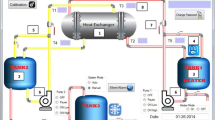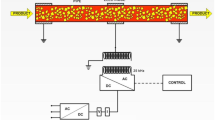Abstract
In this research, our chief aim was to survey possible improvements in thermophysical properties of nanofluids when they are used as heating mediums for time reduction and energy saving in food industries for the first time. Accordingly, three different variables of temperature (70, 80, and 90 °C), alumina nanoparticle concentration (0, 2, and 4 %), and time (30, 60, and 90 s) were selected for thermal processing of tomato juice by a shell and tube heat exchanger. Our results revealed that incorporation of nanoparticles could raise density, viscosity, and thermal conductivity and decrease heat capacity, but this increasing/decreasing trend was linear or non-linear depending on the diameter of the nanoparticles. Four percent Al2O3–water, compared with 2 % nanofluid and pure water (0 % nanofluid), had the highest overall heat transfer coefficients for all Re numbers. Incorporating nanoparticles into the base heating fluid of water could augment the effectiveness of the heat exchanger by 49 %. Thermal processing time of tomato juice was shorter for 2 and 4 % nanofluids, compared with water, by 22.23 and 46.29 %, respectively; this time reduction caused energy saving rates for 2 and 4 % nanofluids to be improved by 22.3 and 48.76 %, respectively.







Similar content being viewed by others
Abbreviations
- A:
-
Heat transfer area (m2)
- Cp :
-
Specific heat (kJ kg−1 K−1)
- D:
-
Tube diameter (m)
- d:
-
Nanoparticle diameter (m)
- h:
-
Heat transfer coefficient (W m−2 K−1)
- k:
-
Thermal conductivity (W m−1 K−1)
- L:
-
Tube length (m)
- m:
-
Mass flow rate (kg s−1 )
- Nu:
-
Nusselt number
- Pe :
-
Peclet number
- Pr :
-
Prandtl number
- Q:
-
Heat quantity (W)
- Re:
-
Reynolds number
- T:
-
Temperature (K)
- U:
-
Overall heat transfer coefficient (W m−2 K−1)
- V:
-
Flow velocity (m s−1)
- ƒ:
-
Coefficient of friction
- ∆p:
-
Pressure drop (Pa)
- P:
-
Pump power (W)
- α :
-
Thermal diffusivity (m2 s−1)
- ρ :
-
Density (kg m −3 )
- η:
-
Kinematic viscosity (m2 s−1)
- φ :
-
Volume concentration (%)
- ∆Tlm :
-
Log mean temperature difference
- f:
-
Fluid
- in:
-
Inlet
- m:
-
Mean
- nf:
-
Nanofluid
- out:
-
Outlet
- p:
-
Particle
- w:
-
Wall
- i:
-
Inside
- o:
-
Outside
- H:
-
Hot
- C:
-
Cold
- min:
-
Minimum
- max:
-
Maximum
References
Adekunte, A. O., Tiwari, B. K., Cullen, P. J., Scannell, A. G. M., & O’Donnell, C. P. (2010). Effect of sonication on colour, ascorbic acid and yeast inactivation in tomato juice. Food Chemistry, 122(3), 500–507.
Ajmera, S. (2006). The effects of different cooling times and temperatures on tomato sauce lycopene content. MSc thesis: Bowling Green State University.
Albadr, J., Tayal, S., & Alasadi, M. (2013). Heat transfer through heat exchanger using Al2O3 nanofluid at different concentrations. Case Studies in Thermal Engineering, 1, 38–44.
Choi, S. U. S., Zhang, Z. G., Yu, W., Lockwood, F. E., & Grulke, E. A. (2001). Anomalous thermal conductivity enhancement in nanotube suspensions. Applied Physics Letters, 79(14), 2252–2254.
Cortes, C., Esteve, M. J., & Frigola, A. (2008). Color of orange juice treated by high intensity pulsed electric fields during refrigerated storage and comparison with pasteurized juice. Food Control, 19(2), 151–158.
Coulson, J. M., & Richardson, J. F. (1999). Chemical engineering design (third ed.pp. 635–702). London: Butterworth Heinemann.
Farajollahi, B., Etemad, S. G., & Hojjat, M. (2010). Heat transfer of nanofluids in a shell and tube heat exchanger. International Journal of Heat and Mass Transfer, 53, 12–17.
Food and Drug Administration (FDA). (2004). Guidance for industry: juice HACCP hazards and controls guidance, first ed.
Ho, C. J., Wei, L. C., & Li, Z. W. (2010). An experimental investigation of forced convective cooling performance of a microchannel heat sink with Al2O3/water nanofluid. Applied Thermal Engineering, 30, 96–103.
Jabbari, S. S., Jafari, S. M., Dehnad, D., & Shahidi, S.A. (2016). Effects of thermal processing by nanofluids on vitamin C, total phenolics and total soluble solids of tomato juice. Journal of Food Science and Technology, In Press.
Jafari, S. M., Azizi, D., Mirzaei, H., & Dehnad, D. (2016). Comparing quality characteristics of oven-dried and refractance window-dried kiwifruits. Journal of Food Processing and Preservation, 40(3), 362–372.
Jafari, S. M., Saremnejad, F., Dehnad, D., & Rashidi, A. M. (2016a). Evaluation of performance and thermophysical properties of alumina nanofluids as heating medium in a shell and tube exchanger. Journal of Food Process Engineering, Under Review.
Jafari, S. M., Saremnejad, F., Dehnad, D., & Rashidi, A. M. (2016b). Nano-fluid thermal processing of watermelon juice in a shell and tube heat exchanger and evaluating its qualitative properties. Innovative Food Science and Emerging Technologies, Under Review.
Keblinski, P., Phillpot, S. R., Choi, S. U. S., & Eastman, J. A. (2002). Mechanisms of heat flow in suspensions of nano-sized particles (nanofluids). International Journal of Heat and Mass Transfer, 45, 855–863.
Luciu, R. S., Mateescu, T., Cotorobai, V., & Mare, T. (2009). Nusselt number and convection heat transfer coefficient for a coaxial heat exchanger using Al2O3–water pH=5 Nano-fluid. Bulletin of the Polytechnic Institute of Jassy, Constructions, Architechture Section, 2, 71–80.
Mare, T., Halelfadl, S., Sow, O., Estelle, P., Duret, S., & Bazantay, F. (2011). Comparison of the thermal performances of two nanofluids at low temperature in a plate heat exchanger. Experimental Thermal and Fluid Science, 35(8), 1535–1543.
Nasiri, M., Etemad, S. G., & Bagheri, R. (2011). Experimental heat transfer of nanofluid through an annular duct. International Communications in Heat and Mass Transfer, 38(7), 958–963.
Nguyen, C. T., Roy, G., & Lajoie, P. R. (2005). Refroidissement des microprocesseurs a haute performance en utilisant des Nano-fluids. In Proceedings of Congres Francais de Thermique SFT, Université de Reims Champagne-Ardenne, France, pp. 483–488.
Pak, B. C., & Cho, Y. I. (1998). Hydrodynamic and heat transfer study of dispersed fluids with submicron metallic oxide particles. Experimental Heat Transfer, 11, 151–170.
Palm, S. J., Roy, G., & Nguyen, C. T. (2006). Heat transfer enhancement with the use of nanofluids in radial flow cooling systems considering temperature-dependent properties. Applied Thermal Engineering, 26, 2209–2218.
Pandey, S. D., & Nema, V. K. (2012). Experimental analysis of heat transfer and friction factor of nanofluid as a coolant in a corrugated plate heat exchanger. Experimental Thermal and Fluid Science, 38, 248–256.
Peyghambarzadeh, S. M., Hashemabadi, S. H., Hoseini, S. M., & Seifi Jamnani, M. (2011). Experimental study of heat transfer enhancement using water/ethylene glycol based nanofluids as a new coolant for car radiators. International Communications in Heat and Mass Transfer, 38, 1283–1290.
Pritiviraj, M., & Andrews, M. J. (1996). A numerical investigation of the 3-D flow in shell and tube heat exchangers, Proceedings of the ASME Heat Transfer Division, Vol. 4, ASM.
Putra, N., Septiadi, W. N., Julian, G., Maulana, A., & Irwansyah, R. (2013). An experimental study on thermal performance of Nano-fluids in microchannel heat exchanger. International Journal of Technology, 2, 167–177.
Richardson P. (2008). Pack processed foods improving quality, first ed., Woodhead Publishing, p.34.
Wen, D., & Ding, Y. (2004). Experimental investigation into convective heat transfer of nanofluids at the entrance region under laminar flow conditions. International Journal of Heat and Mass Transfer, 47, 5181–5188.
Worth, D., & Mascone, C. F. (1991). Heat transfer heads into the 21st century, Chemical Engineering Progress.
Xuan, Y., & Li, Q. (2003). Investigation on convective heat transfer and flow features of Nano-fluids. Journal of Heat Transfer, 125, 151–155.
Xuan, Y., & Roetzel, W. (2000). Conceptions for heat transfer correlation of Nano-fluid. International Journal of Heat and Mass Transfer, 43, 3701–3707.
Zeinali Heris, S., Noie, S. H., Talaii, E., & Sargolzaei, J. (2011). Numerical investigation of Al2O3/water nanofluid laminar convective heat transfer through triangular ducts. Nanoscale Research Letters, 6(1), 179–189.
Acknowledgment
The Iran National Science Foundation (INSF) and the Iran Nanotechnology Initiative Council (INIC) are appreciated for the financial support.
Author information
Authors and Affiliations
Corresponding author
Rights and permissions
About this article
Cite this article
Jafari, S.M., Jabari, S.S., Dehnad, D. et al. Heat Transfer Enhancement in Thermal Processing of Tomato Juice by Application of Nanofluids. Food Bioprocess Technol 10, 307–316 (2017). https://doi.org/10.1007/s11947-016-1816-9
Received:
Accepted:
Published:
Issue Date:
DOI: https://doi.org/10.1007/s11947-016-1816-9




